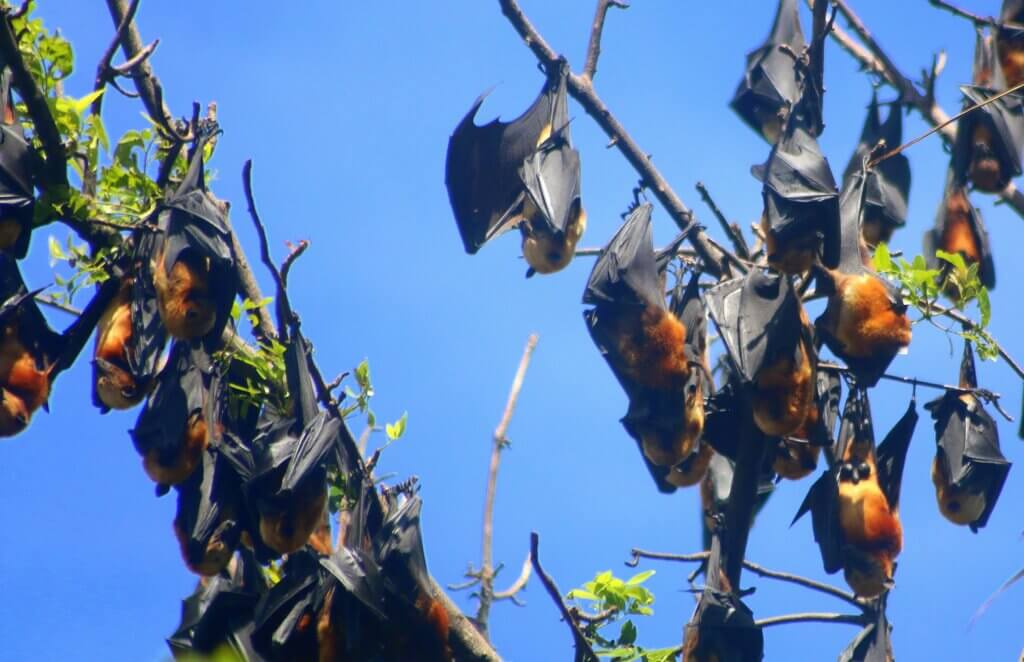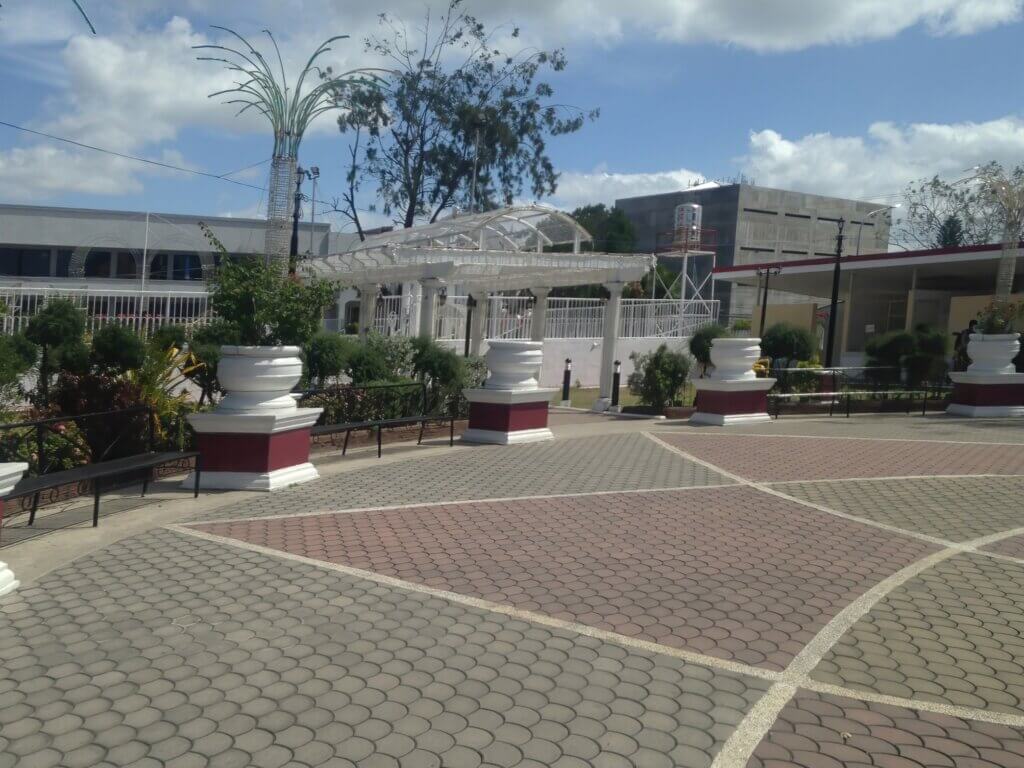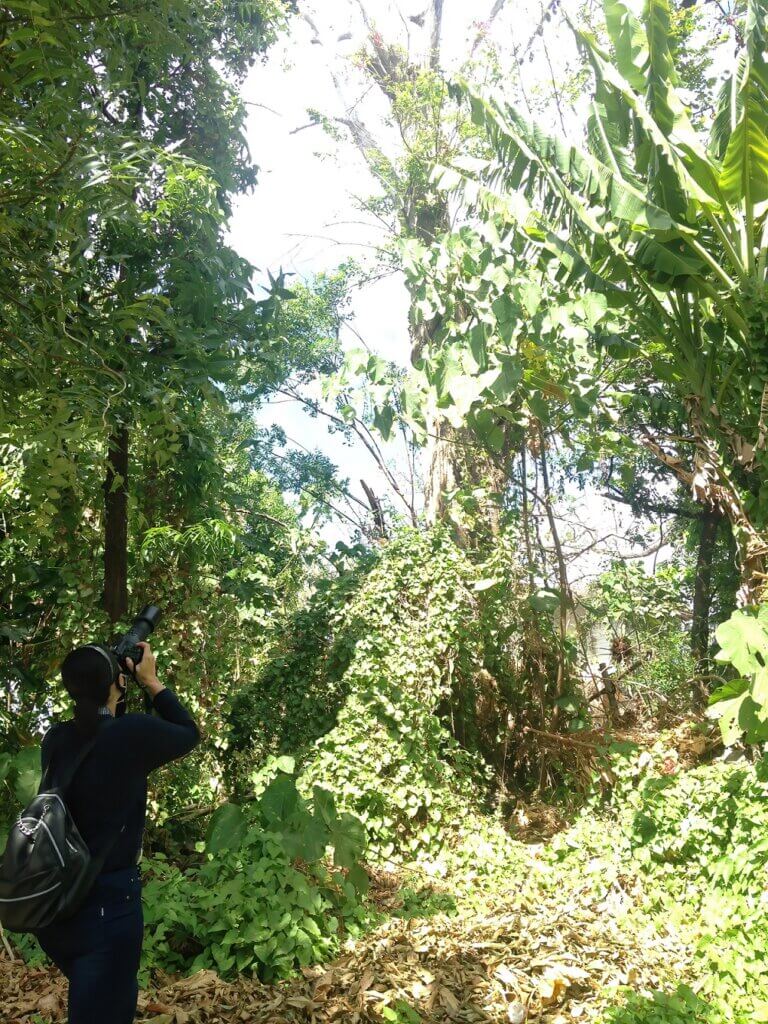Surveys of Fruit Bats in Miag-ao
2022
January 2022
The first bat population count survey for the current year 2022 was conducted last January 16-18, 2022.

The island flying fox roosting at a Caimito tree.
The same visual method was used and based on the count last September 2021 (click here to learn the 2021 survey results), there were forty-six (46) individual trees recorded, with fourteen (14) species. This year, there are only twenty-seven (27) individual trees left being roosted by the island flying foxes, with only eleven (11) species left. There was a 41.30% decline in the number of their roosting sites and a 21.43% decrease in the number of species recorded, compared to last year’s data.
The eleven (11) species of trees are Mahogany (Swietenia macrophylla), Acacia (Samanea saman), Caimito (Chrysophyllum cainito), Coconut (Cocos nucifera), Gmelina (Gmelina arborea), Santol (Sandoricum koetjape), Lanete (Wrightia pubescens), Narra (Pterocarpus indicus), Sambag (Tamarindus indica), Kamansi (Artocarpus camansi), and Duldol (Ceiba pentandra). The three (3) species of trees missing from last year’s survey are Agoho (Casuarina equisetifolia), Mango (Mangifera indica) and Lunok (Ficus). Nineteen (19) out of the forty-six (46) roosting trees last year were abandoned by the island flying foxes.
Last year, there was a total of seven thousand three hundred ninety-two (7,392) individual bats and the highest count in a tree was from the Acacia tree with one thousand forty-four (1,044) ± 4 individuals and the least was from the 2 Agoho trees beside Miag-ao Church with only three (3) counts each. This year, the total population went down to three thousand five hundred ninety-three (3,593) individuals with four hundred eighty-six (486) counts on an Acacia tree as the highest count per tree and the least count was two (2) in a Mahogany tree.



The trees beside the church and around the municipal plaza were abandoned by the flying foxes probably because some were cut down, the Typhoon Odette or the Christmas lights last December.
Table 1. Distribution of the Bat Population among different trees around Miag-ao town plaza (as of September 2021).
TREE # | TREE SPECIES | TREE RATING CONDITION | COUNT | NUMBER OF BATS (MEAN ± SEM) | ||
1st COUNT | 2nd COUNT | 3rd COUNT | ||||
1 | Agoho (Casuarina equisetifolia) | 5 | 28 | 25 | 25 | 26 ± 1 |
2 | Agoho (Casuarina equisetifolia) | 5 | 3 | 3 | 3 | 3 |
3 | Agoho (Casuarina equisetifolia) | 5 | 3 | 3 | 3 | 3 |
4 | Agoho (Casuarina equisetifolia) | 5 | 65 | 90 | 74 | 76 ± 7 |
5 | Agoho (Casuarina equisetifolia) | 5 | 74 | 65 | 69 | 69 ± 3 |
6 | Agoho (Casuarina equisetifolia) | 5 | 153 | 155 | 155 | 154 ± 1 |
7 | Agoho (Casuarina equisetifolia) | 5 | 130 | 132 | 130 | 131 ± 1 |
8 | Agoho (Casuarina equisetifolia) | 5 | 120 | 132 | 136 | 129 ± 5 |
9 | Agoho (Casuarina equisetifolia) | 5 | 149 | 152 | 150 | 150 ± 1 |
10 | Agoho (Casuarina equisetifolia) | 5 | 124 | 129 | 129 | 127 ± 2 |
11 | Agoho (Casuarina equisetifolia) | 5 | 117 | 115 | 117 | 116 ± 1 |
12 | Narra (Pterocarpus indicus) | 5 | 250 | 250 | 251 | 250 |
13 | Agoho (Casuarina equisetifolia) | 4 | 154 | 160 | 158 | 157 ± 2 |
14 | Agoho (Casuarina equisetifolia) | 4 | 197 | 208 | 202 | 202 ± 3 |
15 | Indian Mango (Mangifera indica) | 5 | 237 | 259 | 247 | 248 ± 7 |
16 | Mahogany (Swietenia macrophylla) | 5 | 41 | 52 | 49 | 47 ± 3 |
17 | Coconut (Cocos nucifera) | 4 | 32 | 35 | 35 | 34 ± 1 |
18 | Coconut (Cocos nucifera) | 4 | 5 | 5 | 5 | 5 |
19 | Mahogany (Swietenia macrophylla) | 3 | 228 | 233 | 221 | 227 ± 3 |
20 | Caimito (Chrysophyllum cainito) | 2 | 35 | 33 | 34 | 34 ± 1 |
21 | Santol (Sandoricum koetjape) | 3 | 132 | 135 | 129 | 132 ± 2 |
22 | Caimito (Chrysophyllum cainito) | 5 | 17 | 26 | 24 | 22 ± 3 |
23 | Lanete (Wrightia pubescens) | 5 | 15 | 16 | 15 | 15 |
24 | Mahogany (Swietenia macrophylla) | 4 | 291 | 296 | 287 | 291 ± 3 |
25 | Mahogany (Swietenia macrophylla) | 3 | 235 | 250 | 238 | 241 ± 5 |
26 | Mahogany (Swietenia macrophylla) | 5 | 125 | 130 | 132 | 129 ± 2 |
27 | Coconut (Cocos nucifera) | 4 | 10 | 10 | 10 | 10 |
28 | Caimito (Chrysophyllum cainito) | 5 | 81 | 79 | 87 | 82 ± 2 |
29 | Indian Mango (Mangifera indica) | 3 | 480 | 495 | 489 | 488 ± 4 |
30 | Mahogany (Swietenia macrophylla) | 5 | 156 | 159 | 160 | 158 ± 1 |
31 | Mahogany (Swietenia macrophylla) | 3 | 113 | 130 | 118 | 120 ± 5 |
32 | Mahogany (Swietenia macrophylla) | 5 | 8 | 8 | 8 | 8 |
33 | Narra (Pterocarpus indicus) | 2 | 291 | 314 | 302 | 302 ± 7 |
34 | Caimito (Chrysophyllum cainito) | 1 | 146 | 149 | 152 | 149 ± 2 |
35 | Sambag (Tamarindus indica) | 3 | 205 | 213 | 209 | 209 ± 2 |
36 | Acacia (Samanea saman) | 1 | 977 | 983 | 985 | 982 ± 2 |
37 | Lunok (Ficus sp.) | 4 | 19 | 19 | 19 | 19 |
38 | Acacia (Samanea saman) | 2 | 1050 | 1045 | 1036 | 1044 ± 4 |
39 | Mahogany (Swietenia macrophylla) | 4 | 17 | 17 | 17 | 17 |
40 | Gmelina (Gmelina arborea) | 5 | 57 | 63 | 67 | 62 ± 3 |
41 | Gmelina (Gmelina arborea) | 4 | 27 | 30 | 30 | 29 ± 1 |
42 | Mahogany (Swietenia macrophylla) | 3 | 309 | 311 | 300 | 307 ± 3 |
43 | Mango (Mangifera odorata) | 3 | 118 | 128 | 125 | 124 ± 3 |
44 | Kamansi (Artocarpus camansi) | 4 | 73 | 77 | 68 | 73 ± 3 |
45 | Duldol (Ceiba pentandra) | 5 | 44 | 48 | 39 | 44 ± 3 |
46 | Acacia (Samanea saman) | 3 | 145 | 132 | 151 | 143 ± 6 |
Table 2. Distribution of the Bat Population among different trees around Miag-ao town plaza (as of January 2022).
TREE # | TREE SPECIES | TREE RATING CONDITION | COUNT | NUMBER OF BATS (MEAN ± SEM) | ||
1st COUNT | 2nd COUNT | 3rd COUNT | ||||
1 | Agoho (Casuarina equisetifolia) | 0 | 0 | 0 | 0 | 0 |
2 | Agoho (Casuarina equisetifolia) | 0 | 0 | 0 | 0 | 0 |
3 | Agoho (Casuarina equisetifolia) | 0 | 0 | 0 | 0 | 0 |
4 | Agoho (Casuarina equisetifolia) | 0 | 0 | 0 | 0 | 0 |
5 | Agoho (Casuarina equisetifolia) | 5 | 0 | 0 | 0 | 0 |
6 | Agoho (Casuarina equisetifolia) | 5 | 0 | 0 | 0 | 0 |
7 | Agoho (Casuarina equisetifolia) | 5 | 0 | 0 | 0 | 0 |
8 | Agoho (Casuarina equisetifolia) | 5 | 0 | 0 | 0 | 0 |
9 | Agoho (Casuarina equisetifolia) | 5 | 0 | 0 | 0 | 0 |
10 | Agoho (Casuarina equisetifolia) | 5 | 0 | 0 | 0 | 0 |
11 | Agoho (Casuarina equisetifolia) | 5 | 0 | 0 | 0 | 0 |
12 | Narra (Pterocarpus indicus) | 5 | 0 | 0 | 0 | 0 |
13 | Agoho (Casuarina equisetifolia) | 4 | 0 | 0 | 0 | 0 |
14 | Agoho (Casuarina equisetifolia) | 4 | 0 | 0 | 0 | 0 |
15 | Indian Mango (Mangifera indica) | 5 | 0 | 0 | 0 | 0 |
16 | Mahogany (Swietenia macrophylla) | 5 | 98 | 100 | 101 | 100 ± 1 |
17 | Coconut (Cocos nucifera) | 4 | 44 | 43 | 40 | 42 ± 1 |
18 | Coconut (Cocos nucifera) | 4 | 24 | 23 | 25 | 24 ± 1 |
19 | Mahogany (Swietenia macrophylla) | 3 | 107 | 107 | 106 | 107 |
20 | Caimito (Chrysophyllum cainito) | 2 | 369 | 353 | 345 | 356 ± 7 |
21 | Santol (Sandoricum koetjape) | 3 | 150 | 157 | 14 | 150 ± 4 |
22 | Caimito (Chrysophyllum cainito) | 5 | 28 | 23 | 22 | 24 ± 2 |
23 | Lanete (Wrightia pubescens) | 5 | 6 | 6 | 6 | 6 |
24 | Mahogany (Swietenia macrophylla) | 4 | 211 | 206 | 217 | 211 ± 3 |
25 | Mahogany (Swietenia macrophylla) | 3 | 32 | 40 | 32 | 35 ± 3 |
26 | Mahogany (Swietenia macrophylla) | 5 | 121 | 129 | 123 | 124 ± 2 |
27 | Coconut (Cocos nucifera) | 4 | 0 | 0 | 0 | 0 |
28 | Caimito (Chrysophyllum cainito) | 5 | 0 | 0 | 0 | 0 |
29 | Indian Mango (Mangifera indica) | 3 | 0 | 0 | 0 | 0 |
30 | Mahogany (Swietenia macrophylla) | 5 | 0 | 0 | 0 | 0 |
31 | Mahogany (Swietenia macrophylla) | 3 | 28 | 26 | 30 | 28 ± 1 |
32 | Mahogany (Swietenia macrophylla) | 5 | 2 | 2 | 2 | 2 |
33 | Narra (Pterocarpus indicus) | 2 | 161 | 169 | 169 | 166 ± 3 |
34 | Caimito (Chrysophyllum cainito) | 1 | 146 | 147 | 146 | 146 |
35 | Sambag (Tamarindus indica) | 3 | 472 | 462 | 478 | 471 ± 5 |
36 | Acacia (Samanea saman) | 1 | 261 | 258 | 269 | 263 ± 3 |
37 | Lunok (Ficus sp.) | 4 | 329 | 334 | 327 | 330 ± 2 |
38 | Acacia (Samanea saman) | 2 | 485 | 483 | 490 | 486 ± 2 |
39 | Mahogany (Swietenia macrophylla) | 4 | 88 | 89 | 92 | 90 ± 1 |
40 | Gmelina (Gmelina arborea) | 5 | 24 | 24 | 24 | 24 |
41 | Gmelina (Gmelina arborea) | 4 | 19 | 19 | 19 | 19 |
42 | Mahogany (Swietenia macrophylla) | 3 | 30 | 29 | 30 | 30 |
43 | Mango (Mangifera odorata) | 3 | 76 | 72 | 79 | 76 ± 2 |
44 | Kamansi (Artocarpus camansi) | 4 | 63 | 62 | 67 | 64 ± 2 |
45 | Duldol (Ceiba pentandra) | 5 | 58 | 56 | 52 | 55 ± 2 |
46 | Acacia (Samanea saman) | 3 | 167 | 161 | 164 | 164 ± 2 |
Ten (10) out of the twenty-seven (27) roosting trees are Mahogany trees, followed by three (3) Acacia trees, two (2) Caimito and Coconut trees, one (1) of each remaining tree species recorded.
The highest total average count per tree species is of the Mahogany trees with nine-hundred thirteen (913) total count, followed by Mahogany trees with seven hundred thirty-one (731) total count, Sambag tree with four hundred seventy-one (471) bats, Caimito trees with one hundred seventy-one (171) bats, Narra tree with one hundred sixty-six (166) bats, Santol tree with one hundred fifty (150) bats, Gmelina tree with one hundred fourteen (114) bats, Coconut trees with sixty-six (66), Kamansi tree with sixty-four (64) bats, Duldol tree with fifty-five (55) bats and Lanete tree with only six (6) bats.


SGF Senior Science Officer, Norielle Diamante conducting and documenting the bats during the survey.
The decrease in the total bat population compared to last year was 3,799, which makes it a 51.39% decline. There are many possible reasons for this:
1. The Island Flying Foxes may have abandoned the other trees since four (4) of the Agoho trees beside the church were cut down after the Typhoon Odette struck last year.
2. Also, bats are no longer roosting on the trees in the Municipal Plaza. This might be due to the excessive bright lights during the Christmas season, but also not likely since the bats migrate out by 6 PM and return to roost at about 5 AM.
3. Bats might have found other roosting sites beyond the plaza to other nearby places. Inspections of other villages around the plaza did not show any new roosting sites. One possibility is that there may be large numbers found in other locations beyond the town.
4. Perhaps there was a high mortality in the intervening months.
The bat population is planned to be regularly monitored every four (4) months to observe and analyze its population trend. The next bat population count will be conducted in May this year.
Written by: Senior Science Officer, Norielle Diamante (See profile)
